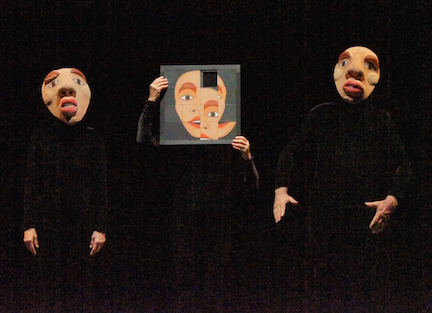
The playfulness of silence
Garbed entirely in velvety black unitards, the four performers who currently comprise Mummenschanz delighted an audience of the perpetually young at Cal Performances Zellerbach Hall this past weekend.
The shorter members of the audience, those pre-teenagers dressed in their own performance duds, were especially thrilled. Their laughter and giggles decorating the silent antics that appeared on the dark stage.
Mummenschanz was founded in 1972, the brainchild of three young actors studying mime and physical comedy in Europe: Swiss actors Andre Brossard and Bernie Schurch and Italian-American Floriana Frassetto. Today, 44 years later, only Frassetto continues to perform, though Schurch continues to work with the company.
Their company’s theater was a radical move away from the white-faced clowns and mimes that dominated pantomime and physical comedy at the time. And many of the skits that they performed are classics of the repertoire and signatures pieces of their performance.
True, the actors are silent like mimes, but they are not alone on stage. Mummenschanz is a comedy of animation. Under the performers skillful fingertips and trained bodies, objects come alive. Huge yellow Slinky-like tubes carry on fitful conversations with enormous red balloons. A velvety beanbag struggles to climb a platform before rolling into an amorphous heap on the floor. Headless figures constructed out of what look like enormous gray plastic garbage bags roll and float in courtly dances their cousin, the Michelin Man, can only dream of.
All of these everyday objects become human. The face – the only part of the performers that is not dressed in black and therefore invisible on stage – is the focus of our attention. Even a rectangle of color can suddenly develop a crease that reads unmistakeably like a frown. Or a smile.
One interaction between characters was comprised of two actors whose face was reconfigured as six rolls of toilet paper: two ears, two eyes, a nose, a mouth. The boy’s rolls are blue, the girl’s pink. Their unsatisfactory love affair is conducted through the unwinding of yards of toilet paper. The paper becomes a tie, long tresses, and more abstractly, the conversation between the two.
Two skits specifically focused on the face. In one, two characters enter the stage wearing huge heads. These heads are undeniably human, but blank in expression. A third figure enters and stands between them, but here the head is two dimensional, the face painted on the surface of giant cube. This image is divided into 16 parts that the actor starts to reassemble, moving the chin upward, the eyes downward, until the entire face becomes a jumble of unrecognizable parts. In that context of action the blankness of the two three-dimensional heads took on a quality of astonishment. Blank and speechless.
In another famous Mummenschanz skit two actors wear masks of shapeable material. Their interaction, which becomes more and more fraught in a battle of one-up-manship, takes place in the manipulation of the masks.
The collisions between the object and the human face are only suggestions, but they are compelling. I could tell I was reading those imaginary reconstructions correctly by the exclamations of the pony-tailed 10-year-old sitting next to me. There was no doubt in her mind that the blob on stage was, all of sudden, human. And that when an object took on the aspects of a human face it was expressive, something that conveyed emotions, simply and recognizably.
That was the joke. The conflation of the human and the material, which in turn became the thrilling entrance into the enigmatic cave of the imagination. And nothing needed explanation. For that brief hour and a half, we and the world of objects around us merged into an animistic whole, where the fantastic and the benign rule in play and silence.
– Jaime Robles
Photo: Cal Performances presented the Swiss mime troupe Mummenschanz at Zellerbach Hall. Photo courtesy Mummenschanz.
